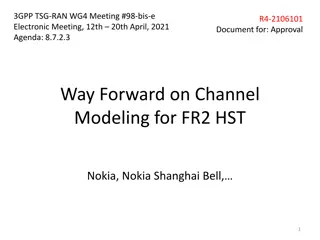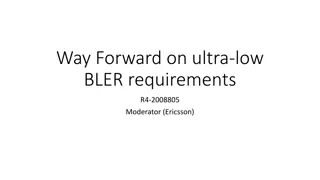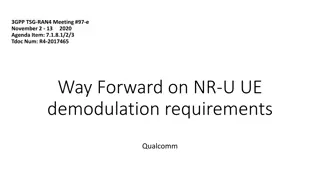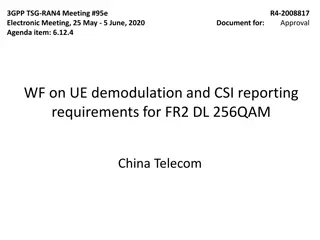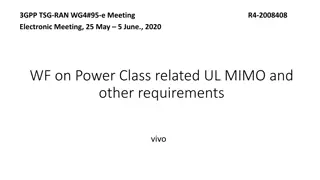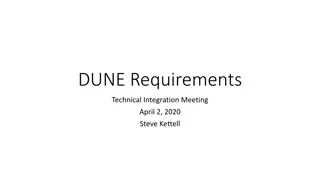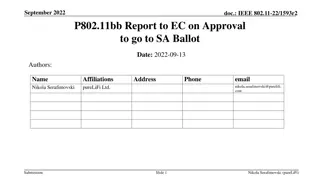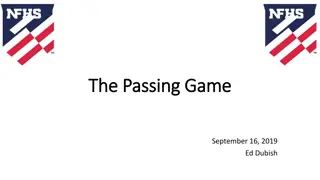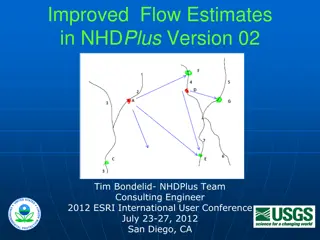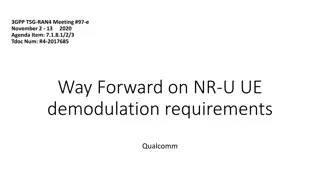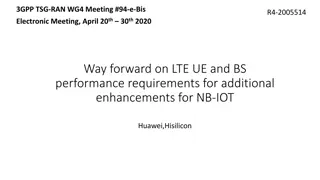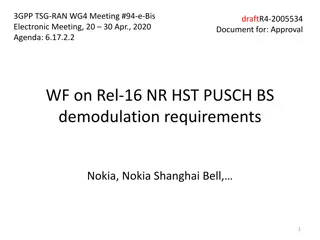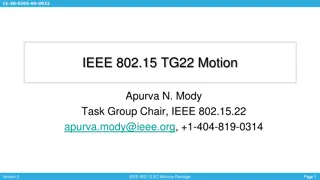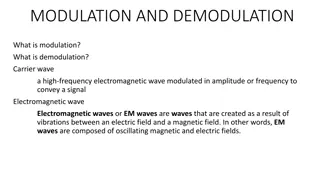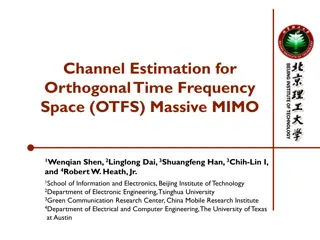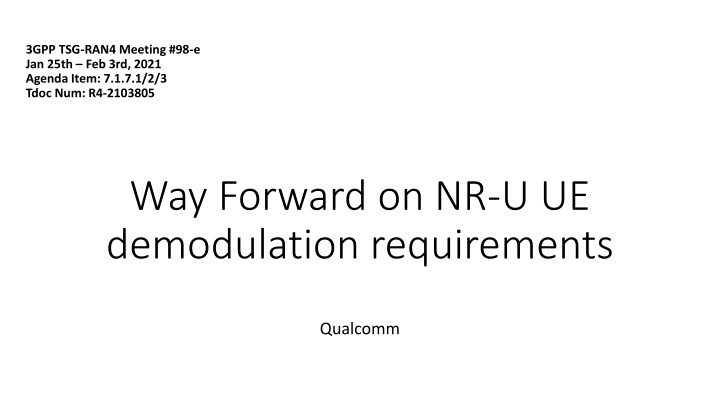
Test Scope and Requirements for NR-U Demodulation in 3GPP TSG-RAN4 Meeting
Explore the comprehensive test scope and requirements for NR-U demodulation in the 3GPP TSG-RAN4 Meeting #98-e. Topics include defining testing scenarios, prioritizing test cases, and setting up CSI validation features for UE capabilities.
Download Presentation

Please find below an Image/Link to download the presentation.
The content on the website is provided AS IS for your information and personal use only. It may not be sold, licensed, or shared on other websites without obtaining consent from the author. If you encounter any issues during the download, it is possible that the publisher has removed the file from their server.
You are allowed to download the files provided on this website for personal or commercial use, subject to the condition that they are used lawfully. All files are the property of their respective owners.
The content on the website is provided AS IS for your information and personal use only. It may not be sold, licensed, or shared on other websites without obtaining consent from the author.
E N D
Presentation Transcript
3GPP TSG-RAN4 Meeting #98-e Jan 25th Feb 3rd, 2021 Agenda Item: 7.1.7.1/2/3 Tdoc Num: R4-2103805 Way Forward on NR-U UE demodulation requirements Qualcomm
Test Scope Semi-static Channel Access Devices v/s Dynamic Channel Access Devices Prioritize test cases agnostic to semi-static and dynamic channel access devices if it is feasible. Do not define additional test cases dedicated to FBE/LBE devices. Tests with SMTC duration larger than COT duration should be deprioritized.
Test Scope Requirement definition according to UE capability of supporting CSI- validation features FFS: Option 1: One generic LBT modelling for all test cases Option 1a: no applicable test cases for UE which does not support CSI-validation features Option 1c: for UE which does not support CSI-validation feature set LBT failure probability as 0. Separate requirements will be introduced. FFS: Option 2: Different test set-up/[performance requirements] for UE with different UE capability Test set1: LBT modelling which applied for UE support CSI validation feature Test set2: Test set-up for UE which does not support support CSI-validation feature FFS how to enable TRS always on considering LBT failure
Test Scope For CSI Validation, define requirements for based on the optional capability csi-RS-ValidationWith-DCI Do not introduce requirements based on optional capability typeB- PDSCH-length-r16.
Test Scope Test Scenarios Define requirements for the unlicensed CC, and apply to both Scenario A and C. If the test setup is the same, define a single set of PDSCH Requirements for the unlicensed CC FFS: Details of the test set-up for scenario A and C; For reference: Scenario A (Carrier aggregation between licensed band NR (PCell) and NR-U (SCell)) Scenario C (Stand-alone NR-U (PCell))
Test Scope Define requirements definition for Scenario A for BW {20,40,60,80} MHz, to reuse the applicability rule in Rel-15 CA to test the largest supported BW. Define requirements for Scenario C for 20 MHz only.
Test Scope Do not define tests for NR-U Demod PDCCH demodulation requirements; Define CQI Requirements at least for UEs supporting optional capabilities related to CSI-RS Validation. The decisions on the CQI Requirements definition for UEs not supporting optional capabilities will follow the agreements reached on the same issue related to PDSCH Requirements.
Test Setup Details Define tests with fixed DRS window duration set to 1ms. Do not consider UL LBT Failure in DL Tests. Reuse Rel-16 NR CA Requirements for the licensed cell where applicable; Define Scenario C PDSCH requirements using Rel-15 NR PDSCH Requirements as a starting point;
Test Setup Details, CQI Performance tests UE reporting following a scheduled CSI-RS transmission cancelled due LBT failure CQI Tests is expected to be disregarded and to be ignored for test pass/fail statistics. FFS Type of CSI reporting: Option 1: Aperiodic CSI; Option 2: Periodic CSI with CSI-RS Validation;
Test Setup Details, CQI Performance tests FFS CQI Performance Test Design: Option 1: Two sets of burst transmissions, each with distinct transmission power level and keeping the interference level constant during the test. Option 2: Two different runs with different SNR values CQI Test Metrics: FFS to study the impact of LBT on PDSCH measurement
Downlink Transmission Model Use Burst Transmission Model for LAA (36.101-4, B.8) as a starting point. Use a fixed DL Transmission Periodicity (or FFP in Dynamic Channel Access). The DL periodicity is 5 ms. The Maximum COT duration within the DL periodicity is 4 ms, to comply with local regulations. Use a Random DL duration within the COT, with equal probability between {2,3,5,6} Slots;
Downlink Transmission Model Details on allocation within the COT Allocate PDCCH in Symbols 0 and 1, in every slot in the DL COT. Allocate PDSCH from Symbol 2 to Symbol 13 in every slot within the DL COT, except for the last slot in the DL COT. Allocate PDSCH in Symbols FFS [{5-14}, {6,9,12,14}] in the last slot in the DL COT. Always schedule UL Slot at the end of the COT within the DL Transmission Periodicity/FFP to avoid Cross-COT HARQ, assuming a minimum guard sufficient according to spec (assuming 1 slot is sufficient). TDD Pattern can be defined once agreements are reached on FFP duration, COT and UL scheduling.
LBT Parameters Model LBT Failure as part of the Downlink Transmission model; Apply the Downlink Transmission model to all DL signals in unlicensed carrier (including SSB and TRS transmission); Define a single LBT model, to be used for both dynamic and semi- static Channel Access; Do not define tests with sub-band LBT failure (either all sub-bands are transmitted, or no sub-band is transmitted).
LBT Parameters Define the same probability of LBT Failure for Scenario C and Scenario A. FFS The probability value is [0.50, 0.25].
Simulation Assumptions for PDSCH Tests Use 20 MHz LBT BW (for channel sensing and clear channel assessment). Do not multiplex SSB and Data. Define tests for TDD 30kHz only. Define tests with low delay spread and low doppler speed propagation channel. ???= 8; Q factor for SSB: ????
Simulation Assumptions for PDSCH Tests Use Type A PDSCH Mapping Type. Do not use PDCCH DCI 2-0 in the PDSCH Tests
Detailed Simulation assumptions [1/3] Reference value Bandwidth (MHz) / Subcarrier spacing (kHz) Modulation format and code rate Correlation matrix and antenna configuration Fraction of maximum throughput (%) Test num. Propagation condition Reference channel Slot Pattern SNR (dB) According to NR- U DL Transmission Model NR-U DL 1-1 [20, 40, 60, 80]/30 16 QAM, 0.48 TDLA30-10 2x2, ULA Low 70 [TBD] Transmission Model Reference value Bandwidth (MHz) / Subcarrier spacing (kHz) Modulation format and code rate Correlation matrix and antenna configuration Fraction of maximum throughput (%) Test num. Propagation condition Reference channel Slot Pattern SNR (dB) According to NR- U DL Transmission Model NR-U DL 2-1 [20, 40, 60, 80]/30 16 QAM, 0.48 TDLA30-10 2x4, ULA Low 70 [TBD] Transmission Model
Detailed Simulation assumptions [2/3] Parameter Unit Value 1 Active DL BWP index Slot Pattern LBT failure probability [TBD, according to decision in the WF] [0.50, 0.25] 0 The first SSB 8 Type A 0 2 According to DL Transmission Model 1 Static 2 Type 0 Config2 Non-interleaved Physical Cell ID SSB position in burst SSB Q factor Mapping type k0 Starting symbol (S) Length (L) PDSCH aggregation factor PRB bundling type PRB bundling size Resource allocation type RBG size VRB-to-PRB mapping type VRB-to-PRB mapping interleaver bundle size DMRS Type Number of additional DMRS Maximum number of OFDM symbols for DL front loaded DMRS Common serving cell parameters PDSCH configuration N/A Type 1 1 PDSCH DMRS configuration 1 RB Allocation MIMO Layers Number of HARQ Processes TX EVM Full BW 2 8 6%
Detailed Simulation assumptions [3/3] Maximum COT Duration Idle Time after COT DL Transmission Model Period/ Fixed Frame Period (Note 1) Probability of LBT Failure pLBT Guard Symbols UL Symbols Number of slots between PDSCH and corresponding HARQ-ACK information ms ms ms [4] [1] [5] [0.25, 0.5] [TBD] [TBD] DL Transmission Model [TBD, HARQ-ACK is sent in any case within the COT, 1 slot after the end of the allocated Downlink portion] [{2,3,5,6}] Duration of the Downlink COT PDSCH Allocation in the last Slot of the COT Slots Symbols [TBD] Notes: 1) The Fixed Frame Period denomination applies only for ChannelAccessType-r16 = semistatic . For ChannelAccessType-r16 = dynamic this parameter is identified only as DL Transmission Model Period.
CR Work Split Item List Description Company PDSCH Performance Requirements for Scenario A 1 - CR Work Ericsson (Can be split in 2/4 RX if needed) PDSCH Performance Requirements for Scenario C 2 - CR Work MediaTek (Can be split in 2/4 RX if needed) 3 - CR Work [CQI Requirements for Scenario A if agreed] Apple 4 - CR Work [CQI Requirements for Scenario C if agreed] [TBD] 5 - CR Work Introduction of new Fixed Reference Channel and TDD Pattern Huawei 6 - CR Work Introduction of new Downlink Transmission Model Qualcomm 7 Simulation Work Collect and Organize Simulation results. Apple


